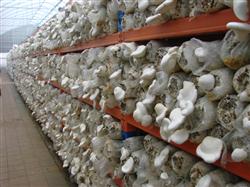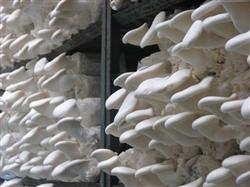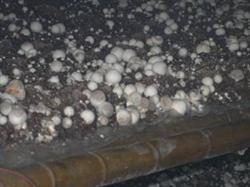New techniques for bag cultivation of Pleurotus ostreatus

Pleurotus ostreatus, also known as Pleurotus ostreatus, also known as Tianshan mushroom, is a kind of edible fungus with strong adaptability, short cycle and easy cultivation. Its meat is thick and tender, the color is white, the nutrition is rich, the taste is delicious, and it is very popular in the market. The artificial cultivation techniques of Pleurotus ostreatus are introduced as follows: (1) Pleurotus ostreatus belongs to medium temperature type mushroom in cultivation season, the optimum temperature for mycelium growth is 24 ℃, and the optimum temperature for long mushroom is 12 ℃. Therefore, the cultivation season should be inoculated in early September, enter Pleurotus ostreatus in mid-October, inoculate in early February in spring and harvest in early May. (2) the mycelium of Pleurotus ostreatus prepared on the culture medium has strong penetration and can make full use of the nutrition of the decomposing matrix. The most suitable high nitrogen formula, commonly used medium formula: (1) cottonseed hull 40%, miscellaneous sawdust 40%, wheat bran 10%, corn flour 8%; (2) miscellaneous sawdust 38%, bagasse 40%, wheat bran 12%, cornmeal 8%: (3) corncob 50%, cottonseed hull 28%, wheat bran 12%. Corn meal 8%. The formula of each group is added with 1% sucrose, 1% gypsum powder, 60%-65% water content, and PH6~7 before sterilization. The temperature is high in autumn, 0.5% lime can be added to the culture medium to prevent acid material. The production method follows the routine. (3) the inoculation cultivation bag should be 15 cm × 32 cm × 0.05 cm or 17 cm × 34 cm × 0.05 cm low-pressure polyethylene film bag. The loading volume accounts for 3 beat 4 of the whole bag, and the remaining 1 stroke 4 is used for fastening or ring stopper. The bacteria were sterilized under normal pressure and kept for 100oC16 hours. When cooled to 25 oC, bacteria were added under sterile conditions. The culture temperature is 25-28 ℃, the indoor air relative humidity is below 70%, and the air is ventilated frequently. The strong light was prevented in the stage of mycelial culture. (4) after 30-45 days of cultivation, when the primordium appears on the material surface or beside the bag, the mycelium can be moved into the mushroom shed to grow mushrooms, and the cultivation method can be planted in the indoor shelf layer or in the open field in the shade shed. The ecological conditions in the field are good, which is beneficial to the growing mushrooms. After the bacterial bag is moved out of the mushroom shed (room), remove the ring and cotton plug and open the mouth of the bag. When the temperature was controlled for 10 ~ 23 ℃, the primordium appeared and differentiated into young buds after 7 days of culture. When the mushroom stalk grows to 2 cm, the amount of spraying water should be added to strengthen ventilation and maintain 80% relative humidity in the space spray in the early stage of ventilation. It is appropriate to master 85% ─ 90% relative humidity in the later stage. The period of growing mushrooms should be "two yang and eight yin". To protect against bright light. (5) harvesting and processing can be harvested when the fruiting body grows to 8cm. The method: hold the fungal stalk in hand and pull up the whole flower. Stop spraying water after harvest, clean up the residue at the mouth of the bag and around, let the mycelium live, continue spraying water after 5 days, control the temperature, promote the growth of 2 tide mushrooms, fresh products directly on the market or salinization, can also be sliced and dried for export.
- Prev

Reuse of waste from Pleurotus ostreatus to cultivate Pleurotus ostreatus
Pleurotus ostreatus, also known as Pleurotus ostreatus, Pleurotus ferulae, Pleurotus ferulae. Pleurotus ostreatus has delicate meat, delicious taste, high edible value, its thick meat cover, delicate texture, crisp and tender, delicious taste, such as abalone, long-cooked not loose, maintain its unique flavor, known as "Boletus on the grassland" and Pleurotus ostreatus, quite popular.
- Next

Summer cultivation of straw mushrooms is timely
1. Cultivation season: Volvariella volvacea belongs to high temperature fungi. The suitable temperature range for the growth of mycelium is 15-40℃, the most suitable temperature is 30-35℃, the temperature for the growth of fruiting body is 26-34℃, and the most suitable temperature is 28-30℃. It is usually cultivated from June to August every year. 2. Cultivation raw materials: cottonseed hull, straw, corncob...
Related
- Fuxing push coffee new agricultural production and marketing class: lack of small-scale processing plants
- Jujube rice field leisure farm deep ploughing Yilan for five years to create a space for organic food and play
- Nongyu Farm-A trial of organic papaya for brave women with advanced technology
- Four points for attention in the prevention and control of diseases and insect pests of edible fungi
- How to add nutrient solution to Edible Fungi
- Is there any good way to control edible fungus mites?
- Open Inoculation Technology of Edible Fungi
- Is there any clever way to use fertilizer for edible fungus in winter?
- What agents are used to kill the pathogens of edible fungi in the mushroom shed?
- Rapid drying of Edible Fungi

